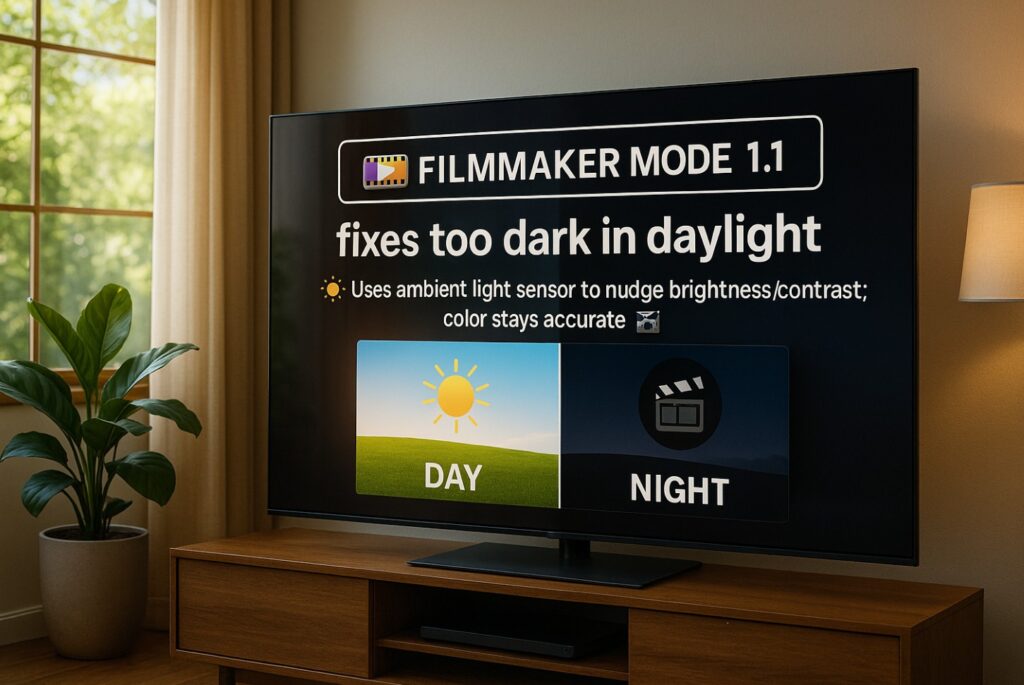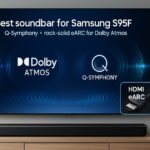LG Filmmaker Mode 1.1 finally addresses the classic “too dark in daylight” complaint by using the TV’s ambient-light sensor to nudge brightness/contrast for the actual room you’re in—without wrecking color accuracy. If your movies look fantastic at night but muted at noon, this feature is for you. 🌞🎬
FMM 1.1 (Ambient Light Compensation) is a standards-level update from the UHD Alliance; 2025 LG OLEDs such as C5/G5 support it, with broader rollout expected across brands.
Quick Takeaways
- What it is: a smarter Filmmaker Mode that references your room light via the TV sensor, lifting visibility only as much as needed.
- What it isn’t: it doesn’t “torch” the image or change creative intent in a dark room—in very dim rooms it does almost nothing (by design).
- Why you’ll care: daytime viewing gains punch and shadow detail without switching to “vivid” or enabling heavy tone-mapping. 🧠✨
What “LG Filmmaker Mode 1.1” changes (vs classic FMM)
| Aspect | Classic Filmmaker Mode | LG Filmmaker Mode 1.1 |
|---|---|---|
| Ambient light behavior | Fixed; assumes dark room | Adaptive: reads room light, applies controlled compensation |
| Color intent & EOTF | Strict preservation | Preserved; compensation is bounded for fidelity |
| When it helps most | Nighttime / blackout rooms | Daytime / mixed lighting (living rooms, open kitchens) |
| DV integration | DV content respected, no ambient logic | Works alongside DV concepts like IQ-style sensing (model/firmware-dependent) |
Based on the UHD Alliance update and hands-on coverage of FMM 1.1 and ambient-light compensation on 2025 LG TVs.
How LG Filmmaker Mode 1.1 works (the simple version)
- The TV’s ambient-light sensor reports the room’s illuminance.
- The TV applies bounded adjustments (gamma/contrast/ABL windows) to preserve near-black detail and specular highlights while avoiding raised blacks.
- In a dark room, adjustments trend to zero; in bright light, they increase just enough to keep the image readable.
Set-up on LG webOS (C5/G5 and newer)
- Update firmware (Settings → Support → Software Update) and ensure the ambient light sensor is enabled.
- For movies, choose Filmmaker Mode (or Dolby Vision Filmmaker when applicable).
- Keep Energy Saving off during HDR testing.
- If you use external boxes (Apple TV/console), match frame rate/dynamic range on device, and leave tone-mapping to the TV while using FMM 1.1.
Tip: If you prefer absolute reference at night, create two presets: FMM 1.1 (Day) with sensor on, and FMM (Night) with the sensor effectively giving zero compensation. 🌙
Day vs Night: the clean recipes
Bright daytime room (curtains open)
- Picture Mode: Filmmaker Mode 1.1
- Ambient sensor: On
- Peak brightness / OLED Pixel Brightness: Default (let FMM 1.1 decide)
- Dynamic Tone Mapping: Off (or HGIG for console HDR movies/games), unless a specific title still looks flat
Dim nighttime room
- Picture Mode: Filmmaker Mode (1.1 will barely intervene)
- Ambient sensor: On (has near-zero effect)
- Keep any energy-saving features Off during movies to avoid mid-scene dimming
These two cover 95% of living-room scenarios with minimal fiddling.
Dolby Vision interplay (what to expect)
- Dolby Vision titles benefit from the same visibility improvements in bright rooms when the TV/platform supports ambient-aware logic (akin to IQ); black levels and color volume remain calibrated for intent.
- Dolby Vision 2 news signals deeper environment-aware control coming to future sets; your current LG will still play today’s DV just fine, but new metadata tiers will be limited to compatible hardware. 📈
Troubleshooting (if FMM 1.1 seems “too dim” or “too bright”)
- Check the sensor: if you’ve disabled the light sensor or covered it with a soundbar bezel, FMM 1.1 can’t adapt.
- Energy Saving interacting? Turn it Off for HDR.
- Raised blacks in extreme light: pull blinds slightly; FMM 1.1 is bounded by design, not a torch mode.
- App looks fine, HDMI looks dim: ensure the external device isn’t enforcing different tone-mapping; keep just one device in charge.
- After a firmware update: power-cycle the TV (unplug 60s) to refresh services. 🔁
Advanced notes (for the curious)
- The UHD Alliance document describes Ambient Light Compensation as a standards-guided algorithm that respects creator intent by limiting adjustments to just-noticeable-difference ranges around the reference EOTF—rather than applying global gamma lifts. 📚
FAQ
Does LG Filmmaker Mode 1.1 change color accuracy?
Within its bounds, no—the compensation targets visibility under ambient light while preserving colorimetry and black floor. In very dark rooms, it’s effectively transparent.
Is this the same as Dolby Vision IQ?
It’s similar in spirit (both are ambient-aware), but FMM 1.1 is a Filmmaker Mode update that can apply across formats; DV IQ is Dolby’s implementation within Dolby Vision.
Will it work with all apps and HDMI sources?
Yes, as a TV picture mode it applies system-wide, but external devices doing their own tone-mapping can change the outcome—avoid stacking multiple tone-mappers.
My room is extremely bright—can FMM 1.1 fully “beat” sunlight?
It helps a lot, but it’s bounded; for glass-walled rooms at noon, modest shading still improves results.
How do I keep pure reference at night?
Use the same mode; in near-darkness the compensation trends toward zero. Some users keep a separate Night preset just to be sure.
Will older LG sets get it?
Rollout details vary by model/SoC. 2025 lines (e.g., C5/G5) feature it; older models may not. Check firmware notes for your exact model.
Does it affect gaming latency?
No change in input lag is expected from the ambient compensation itself; for games, many prefer Game/HGIG presets anyway.
Exact brightness numbers?
FMM 1.1 is adaptive; rather than fixed nits, it targets visibility while staying inside creator-intent bounds. Lab figures vary by model and firmware.
Final Verdict
If you love the look of Filmmaker Mode but hate how it collapses in daylight, LG Filmmaker Mode 1.1 is the elegant fix—ambient-aware, restrained, and faithful. Use it by day for natural pop and keep it at night for reference-grade viewing. Fewer toggles, better pictures. ✅🙂
Recommended internal reads (live on TVComparePro):


